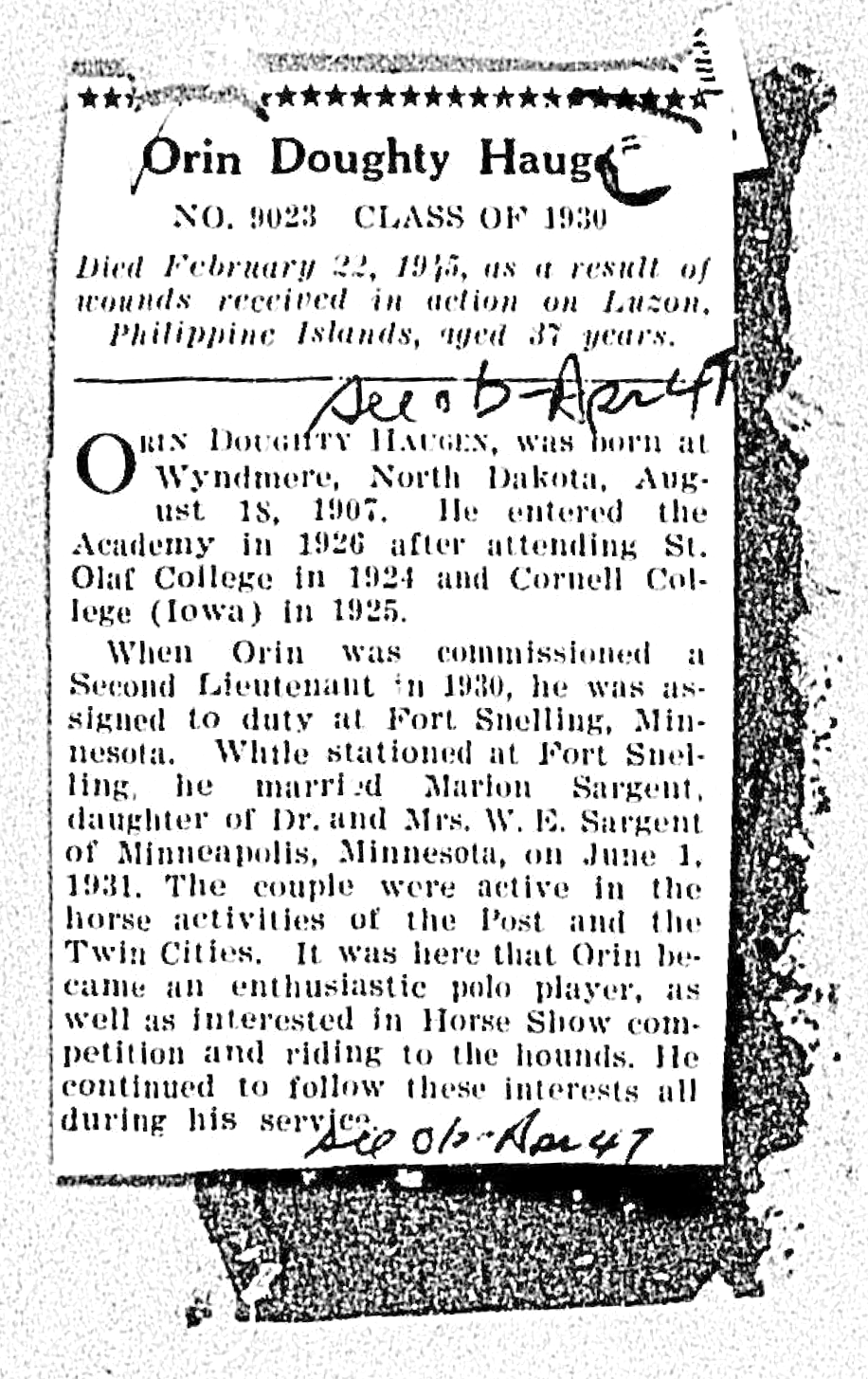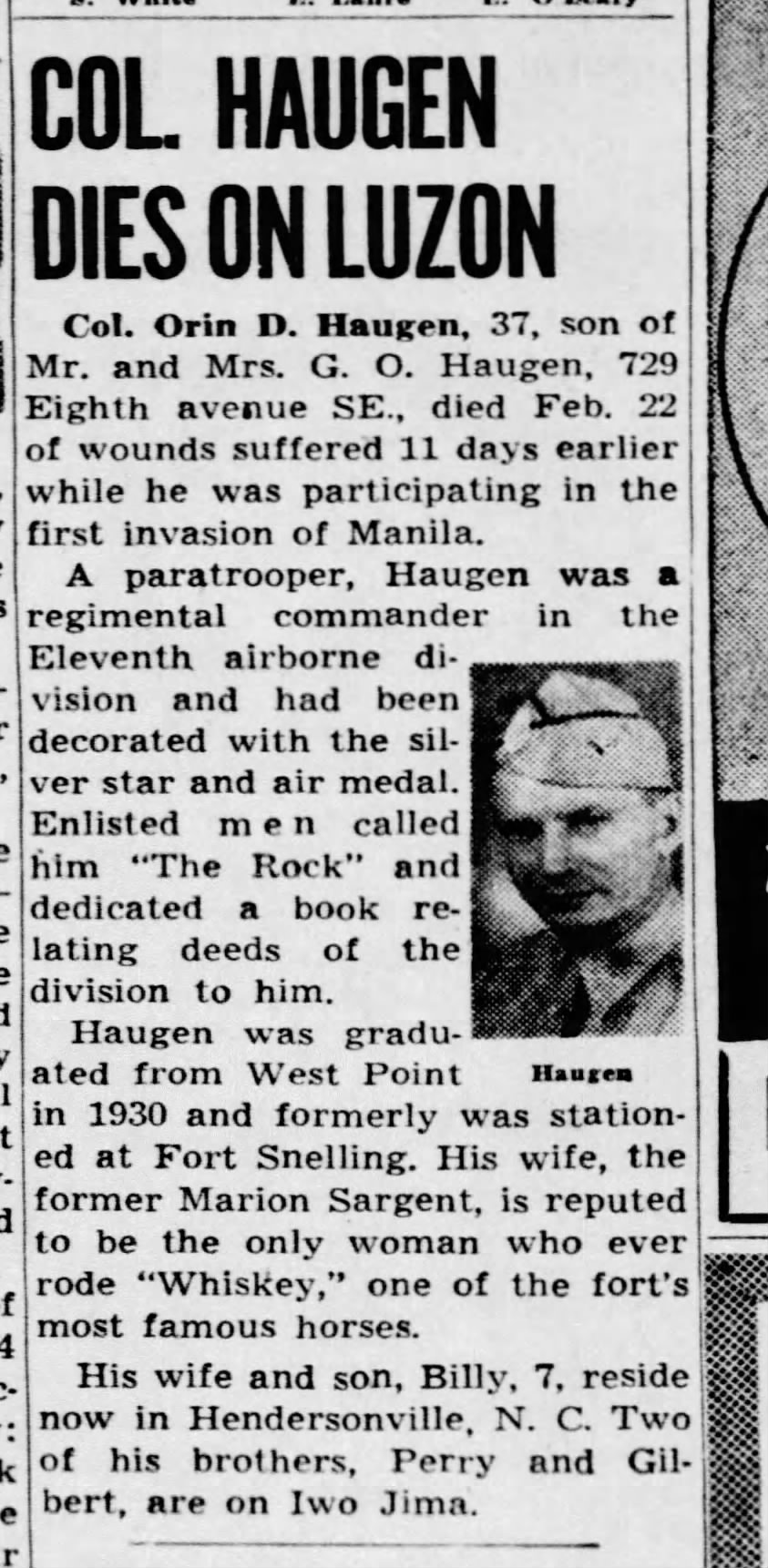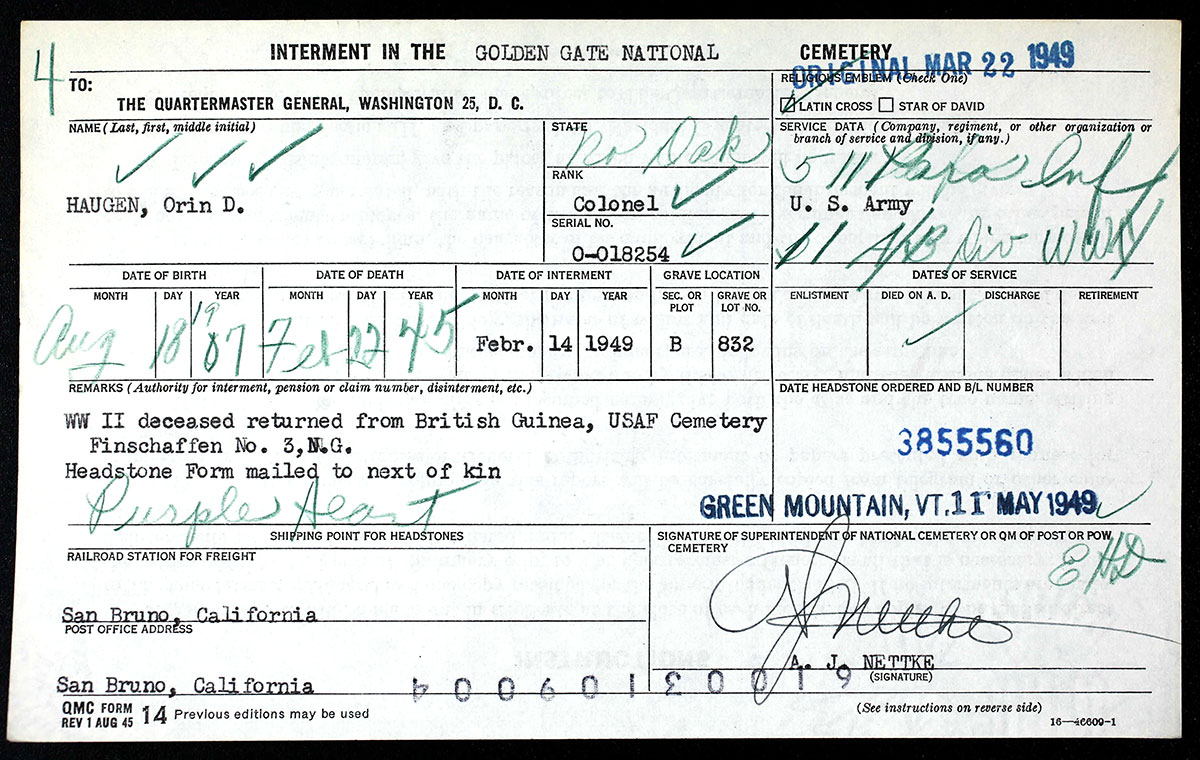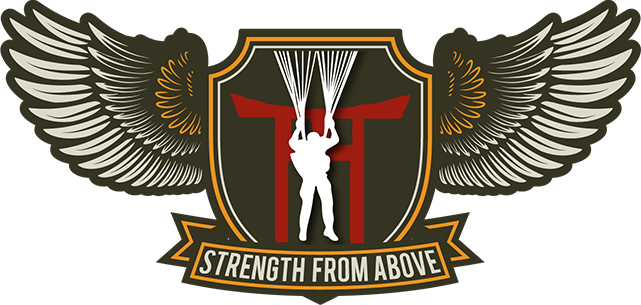Colonel Haugen, Orin D. "Hard Rock"
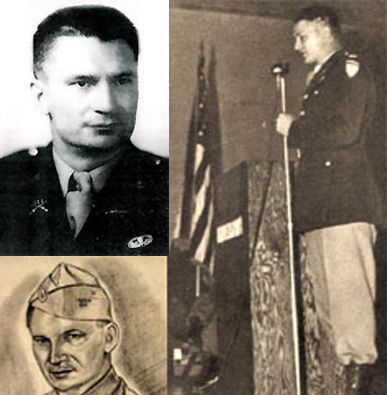
Commanding Officer 511th PIR - KIA
Aug 18, 1907 - Feb 22, 1945 (KIA Age 37) - gravesite - US 6th Army letter RE: Orin's burial in San Francisco
Citations: Silver Star, Legion of Merit, Air Medal, Combat Infantryman Badge
Unit Nickname: "Hard Rock" or "Rock"
Ranks: Began attending West Point July 1, 1926; commissioned 2nd Lieutenant on June 12, 1930; 1st Lieutenant August 1, 1935; Captain June 12, 1940; Major February 1, 1942; Lieutenant Colonel September 25, 1942; Colonel June 2, 1943
Orin D. Haugen was born Aug. 18, 1907, Wyndemere, N.D. to George O. and Georgie Doughty Haugen. He attended St. Olaf College, then Cornell College in 1925. In 1930, Orin was commissioned 2nd Lt., U.S. Military Academy at West Point, then assigned to Fort Snelling, MI. June 1, 1931, married Marion Sergeant, daughter of Dr. and Mrs. W. E. Sergeant, Minneapolis, MN (the Sergeant's spent earlier years in Gettysburg, S.D.). They had one son, William, or "Billy", whom the 511th PIR paratroopers took to calling "Pebble" since his father was "The Rock." The Haugen's were are active in the horse shows at Twin Cities and Orin became a good polo player, and enthusiastically rode to the hounds on fox hunts. He continued to follow these interests all during his service.
In 1933, Orin was ordered to the 21st Infantry, Schofield Barracks, Hawaii. In 1936, attended Regular Course, Infantry School, Fort Benning, GA., then joined the 23rd Infantry, Fort Sam Houston, TX. While with the 32nd Infantry, Fort Ord, CA, in 1940, the War Department requested officers for parachute training. He was among the first to volunteer for this hazardous duty.
 Captain Haugen was assigned as Commander of Company "A" of the 501st Parachute Battalion, the first tactical Parachute unit created by the War Department. He joined the unit at Fort Benning on November 16, 1940, in the morning, and that afternoon made his first parachute jump. The Major then served as Battalion Commander, 502nd PIR, then Executive Officer, 505th PIR.
Captain Haugen was assigned as Commander of Company "A" of the 501st Parachute Battalion, the first tactical Parachute unit created by the War Department. He joined the unit at Fort Benning on November 16, 1940, in the morning, and that afternoon made his first parachute jump. The Major then served as Battalion Commander, 502nd PIR, then Executive Officer, 505th PIR.
In late 1942, Lt. Col. Haugen was assigned Commander, 511th Parachute Infantry Regiment, then being activated at Toccoa, GA. A few months later, he was promoted to Colonel. He often shouted encouragement to his troopers. "YOU ARE THE BEST." Later, they proved it in combat.
During vigorous training at Camp Mackall, NC, Col. Haugen earned the nickname "Hard Rock" derived from his stern discipline combined with respect and affection. This was a true tribute to his durability. The "Rock" was immensely proud of his tough, young paratroopers, whose average age was just under 19 years. The brave and daring deeds of Col. Haugen in combat will be published in later blog posts on the Leyte and Luzon Campaigns, Philippines.
Several 511th officers, and enlisted men, noted that Colonel Haugen more than proved his willingness to lead and fight beside his men while on Leyte. During one engagement, his voice was heard to shout over the radio to General Joseph Swing, "Hell, General! We are surrounded. We don't have to look for the Nips (Japanese) to kill 'em!"
Orin was mortally wounded in action at 1357 on 11 February 1945 near Manila's San Raphael Polo Club. While the 187th and 188th Glider Infantry Regiments cleared sections of Nichols Field, following a 1,000-round artillery barrage to their front the 511th PIR’s 1st and 3rd Battalions pressed north towards the Manila Polo Club near Fort Bonifacio where E Company’s Pvt. George Canales used his M-1 to eliminate 22 Japanese in one day.
Fighting stubborn enemy defenders every step of the way, including at least one enemy tank, the paratroopers made tremendous progress, but it came with a tremendous cost.
Shortly before 1400 Col. Haugen moved with Gens. Swing and Pierson into the CP of the 187th GIR’s LTC Norman E. Tipton of 2nd Battalion to discuss the division’s advancements (D-511 were dug in about 200 yards to the north). When the brass moved around a large oak table to review a map of Manila, Pfc. Richard Loughrin of the 511th’s S-2 noticed the room’s open window. Thinking it was a perfect opportunity for some lucky Japanese gun crew to take out the Angels’ leadership, Loughrin felt inspired to drop to one knee. It may have saved his life as moments later a Japanese 40-mm (some say 20) anti-aircraft shell burst through the window and crashed into the table, sending shrapnel deep into Col. Haugen’s chest which punctured his heart. Another trooper was hit in the throat and quickly bled to death while Sgt. Jerome K. Aigner of HQ2-511 felt a hot piece of shrapnel sear deep into his flesh.
Orin's face grew ashen as he was loaded onto a stretcher and carried down to a jeep. Asking for a cigarette which he then let dangle from the side of his mouth, something he frequently did, Hard Rock waved weakly to his worried men as he was driven away.
It was the last time they would ever see him alive.
At 1430 a hasty radio message went out that shocked the regiment (“Rock got hit in the Chest”) as Col. Haugen was moved to the nearby Las Piñas (St. Joseph Parish) church with its famous 200-year-old bamboo pipe organ. Although an emergency surgical team had set up shop, the surgeons were operating on another serious case, so the division’s dentist provided Rock’s initial care.
After he was stabilized, the medical staff later decided to move Haugen to Mindoro for better care. While there, Orin was visited by his good friend from the 501st PIB Col. George “The Warden” Jones who had taken over the 503rd Parachute RCT. George and the 503rd were preparing to jump on Corregidor, a fact that shocked Col. Haugen who had been stationed on “The Gibraltar of the East” before the war. He knew the steep-sided island was prone to high winds and lacked a suitable drop zone, yet despite Orin’s protests, Jones and the 503rd's "Rock Force" successfully landed (mostly) on The Rock on February 16, much to Col. Haugen’s relief.
Everything seemed to be going well and six days later on February 22, surgeons elected to fly the recovering Hard Rock to Biak Island, Indonesia. Unfortunately, as Orin’s C-47 medical transport flew towards Army Hospital No. 9 at “Base H”, a squadron of Japanese Zeros bounced the flight. Records indicate that the 804th Medical Air Evacuation pilots performed emergency maneuvers and after asking the nurse for a cigarette, Col. Orin D. “Hard Rock” Haugen died. At age thirty-eight, the Rock who had led the 511th through the trials of Camp Toccoa to the training grounds of Fort Benning and Camp Mackall then pushed them at Camp Stoneman and Dobodura before enduring the fires of Leyte and Luzon by their side was gone.
Orin was survived by his wife Marion and their son (then age 7), William Haugen Light, who lived in Hendersonville, North Carolina at the time.
General Douglas MacArthur wrote to Marion:
"In the death of your husband, Colonel Orin D. Haugen, I have lost a gallant comrade-in-arms, and I cannot express to you the poignancy of my regret.
"His service under me in the Southwest Pacific was characterized by his complete devotion to our beloved country and by his death in our crusade for freedom and liberty he is enshrined in its imperishable glory."
Orin's parents received word of his death at their home at 729 Eight Avenue SE in Minneapolis, Minnesota. Orin's two brothers, Perry (Pershing) and Gilbert, were both on Iwo Jima at the time; both brothers survived the war. Orin was also survived by his three sisters: R. Lilliestone, B> Johnson and B. Webb.
Orin was originally buried with full honors in the USAF Cemetery at Finschaffen, New Guinea, but the cemetery was closed so Orin's body was brought home aboard the USAT Sgt. Jack J. Pendleton on January 13, 1949. Since by then Marion and young William had moved to Los Angeles, California, Colonel Haugen's body was re-interred on February 14, 1949 at the Golden Gate Cemetery, Section B, Plot 832.
Orin was a brave and gallant soldier. His constant unselfish devotion to duty was an inspiration to all who knew and served with him. His memory will live always in the hearts of his family and many friends.
When asked what commendations Orin had received, Hard Rock's old West Point classmate Lt. Col. Robert Allen Ports responded: "(He) should have had everything the Army could give him."
Former war correspondent for YANK magazine Mr. William E. Lindau said of Colonel Haugen, "He was one of the bravest and best soldiers I have ever seen."
On Friday, July 19, 1945, while at Lipa, Luzon the 11th Airborne Division held a full dress parade review to honor Colonel Haugen after which his Legion of Merit award was posthumously presented by General Walter Krueger of US Sixth Army (18 other officers and enlisted men were also recognized).
Orin's son, Dr. William Haugen Light, later declared, "He was proud to be a paratrooper and he was very proud of his men in the 511th.
To learn more about Orin's historic unit and the intrepid men who fought in it, you can order Jeremy C. Holm's new book, WHEN ANGELS FALL: From Toccoa to Tokyo, The 511th Parachute Infantry Regiment in World War II by visiting our online store or purchasing a copy wherever books are sold.
